
The Rookwood Cemetery Line used to be a part of the Sydney suburban network. The line serviced Rookwood Cemetery and was built in 1864, opening on 22 October 1864. [2] [3]

The Rookwood Cemetery Line used to be a part of the Sydney suburban network. The line serviced Rookwood Cemetery and was built in 1864, opening on 22 October 1864. [2] [3]

With the closure of the Town Hall and Devonshire Cemeteries by the mid-19th century and an ever-increasing population, a decision was made to purchase a huge area of land (250 acres) in 1862 to establish the Necropolis at Haslem's Creek in 1867. [4] The term "necropolis" comes from the Greek "nekropolis" or "city of the dead".
As this location was some distance from the centre of Sydney and from the main-line train station at Haslem's Creek, now Lidcombe station, it was considered necessary to establish a railway station at the centre of the cemetery. This line would run as a spur line from the existing station at Haslem's creek and allow easier movement into and out of the cemetery. The railway line construction began in November 1864 and from 1 January 1865 trains began their run into the cemetery. [5] However, The Sydney Morning Herald advertised the first regular services from 1 April 1867. The times advertised were for services at 8.30am and 4.15pm. Later this was changed to 9.15am and 3pm. [6] It stopped at prearranged stations on the journey from central Sydney in order to pick up mourners and coffins. [5] Some stations, such as Newtown had special platform areas and buildings reserved for mourners and coffins.
At the time of its opening, the line went as far as Cemetery Station No. 1. On 26 May 1897, an extension of the line to Cemetery Station No. 3 was opened. [3] The extension required the removal of a waiting room on the rear wall of the Cemetery Station No. 1, [2] so the line could pass right through the building. A final extension, to Cemetery Station No. 4 opened on 19 June 1908. [3] The line closed in 1948. [1] [2]

The last trains that ran funeral processions all but ceased in the late 1930s. Following this, they were only used for visitors on Sundays and Mother's Day. [7] The service was briefly revived during World War II during petrol rationing. The last railway timetable was recorded in 1947 and read Sydney 2.17 p.m. to Strathfield 2.33 p.m. to Rookwood #1, 2.50 p.m. [8]
On 3 April 1948, the service was officially terminated while the spur was recorded as closed on 29 December 1948. [9] The tracks remained until the 1980s, with the line used to transport stonework.
Station names are based on the current name of the station, or the name of the station when it was closed.

The London Necropolis Company (LNC), formally the London Necropolis & National Mausoleum Company until 1927, was a cemetery operator established by Act of Parliament in 1852 in reaction to the crisis caused by the closure of London's graveyards in 1851. The LNC intended to establish a single cemetery large enough to accommodate all of London's future burials in perpetuity. The company's founders recognised that the recently invented technology of the railway provided the ability to conduct burials far from populated areas, mitigating concerns over public health risks from living near burial sites. Accordingly, the company bought a very large tract of land in Brookwood, Surrey, around 25 miles (40 km) from London, and converted a portion of it into Brookwood Cemetery. A dedicated railway line, the London Necropolis Railway, linked the new cemetery to the city.

Rookwood Cemetery is a heritage-listed cemetery in Rookwood, Sydney, New South Wales, Australia. It is the largest necropolis in the Southern Hemisphere and is the world's largest remaining operating cemetery from the Victorian era. It is close to Lidcombe railway station about 17 kilometres (11 mi) west of the Sydney central business district. It was added to the New South Wales State Heritage Register on 2 April 1999.

Central is a heritage-listed railway station located in the centre of Sydney, New South Wales, Australia. The station is the largest and busiest railway station in Australia and serves as a major transport interchange for NSW TrainLink inter-city rail services, Sydney Trains commuter rail services, Sydney light rail services, bus services, and private coach transport services. The station is also known as Sydney Terminal. The property was added to the New South Wales State Heritage Register on 2 April 1999. It recorded 85.4 million passenger movements in 2018 and serves over 250,000 people daily.

The Main North Line is a major railway in New South Wales, Australia. It runs through Strathfield to Wallangarra. The line was the original main line between Sydney and Brisbane, however this required a change of gauge at Wallangarra. As of 1988, the line closed progressively north of Armidale with services gradually withdrawn till 2004, with the main route between Sydney and Brisbane now the North Coast line.

London Necropolis railway station was the terminus at Waterloo, London, of the London Necropolis Railway. The London Necropolis Railway was opened in 1854 as a reaction to severe overcrowding in London's existing graveyards and cemeteries. It aimed to use the recently developed technology of the railway to move as many burials as possible to the newly built Brookwood Cemetery in Brookwood, Surrey. This location was within easy travelling distance of London, but distant enough for the dead not to pose any risk to public hygiene. There were two locations for the station; the first was in operation from 1854 to 1902, the second from 1902 to 1941.

Strathfield railway station is a heritage-listed railway station located on the Main Suburban line in the Sydney suburb of Strathfield in the Municipality of Strathfield local government area of New South Wales, Australia. The station is served by Sydney Trains T1 North Shore & Western Line, T9 Northern Line and T2 Inner West & Leppington Line suburban services as well as NSW TrainLink Intercity and regional services. The station is located on the Main Northern and Main Western railway lines, forming a major junction for regional and suburban rail services. The station and associated infrastructure was added to the New South Wales State Heritage Register on 2 April 1999.

Lidcombe railway station is located on the Main Suburban line, serving the Sydney suburb of Lidcombe. It is served by Sydney Trains T1 Western, T2 Inner West & Leppington, T3 Bankstown and T7 Olympic line services.
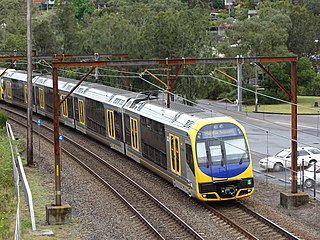
The Central Coast & Newcastle Line (CCN) is a NSW TrainLink passenger train service that runs along the Main North railway line in New South Wales, connecting the state's two largest cities, Sydney and Newcastle. The service runs from Central through to Broadmeadow on the Main North railway line to Newcastle Interchange on the Newcastle railway line, and services the Hawkesbury River region, the Central Coast and the city of Newcastle.

Rookwood is a suburb in western Sydney, in the state of New South Wales, Australia located 14 kilometres (8.7 mi) west of the Sydney central business district, in the local government area of the Cumberland Council. It is the easternmost suburb in greater western Sydney.
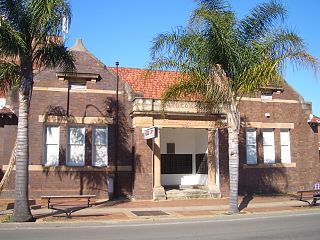
Lidcombe is a suburb in western Sydney, in the state of New South Wales, Australia. Lidcombe is located 15 km (9.32 mi) west of the Sydney central business district, in the local government area of Cumberland Council, with a small industrial part in the north in the City of Parramatta. Post code: 2141, sharing it with Berala.

The Southern Highlands Line (SHL) is an intercity rail service operated by NSW TrainLink that services the Macarthur, Southern Highlands and Southern Tablelands regions of New South Wales. First operating in 1869, the service runs from Campbelltown across the Main Southern railway line through to Goulburn, with peak hour services extending the route to Central. The railway service operates alongside a bus route from Picton to Bowral, operating on the route of the Picton – Mittagong loop railway line, and a regional coach service from Bundanoon to Wollongong on the South Coast Line, operating on the corridor of the Unanderra–Moss Vale railway line.

Muswellbrook railway station is a heritage-listed railway station located on the Main Northern line in Muswellbrook, in the Muswellbrook Shire local government area of New South Wales, Australia. The station serves the town of Muswellbrook and was designed by John Whitton, the Chief Engineer of NSW Railways. It is also known as Muswellbrook Railway Station and yard group and Musclebrook Railway Station. The property was added to the New South Wales State Heritage Register on 2 April 1999.
Cemetery Station No. 4 was a railway station on Sydney's Rookwood Cemetery railway line. It served the Rookwood Cemetery.
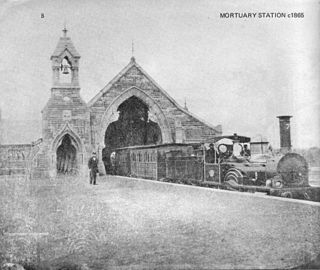
The Cemetery Station No. 1 was a railway station on the Rookwood Cemetery railway line in Sydney, New South Wales, Australia. The station operated between 1867 and 1948 and served the Rookwood Cemetery. The building was designed by NSW Government Architect James Barnet.
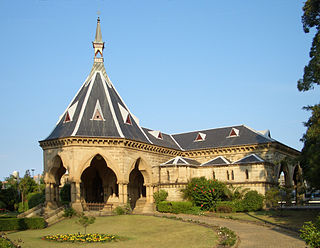
Regent Street railway station, formerly known as the Mortuary railway station, was a railway station on Sydney's Rookwood Cemetery railway line. Funeral trains departed from the station, bound for Rookwood Cemetery. The station found later use as a part of Sydney Yard. The ornate Gothic building is still standing on the western side of Sydney Yard at Chippendale, close to Central railway station and Railway Square. It was added to the New South Wales State Heritage Register on 2 April 1999.

Sydney, the largest city in Australia, has an extensive network of passenger and freight railways. The passenger system includes an extensive suburban railway network, operated by Sydney Trains, a metro network and a light rail network. A dedicated freight network also exists. Future expansion of the light rail network includes the Parramatta Light Rail. Existing light rail services are the Inner West Light Rail and the CBD & South East Light Rail.

A funeral train carries a coffin or coffins (caskets) to a place of interment by railway. Funeral trains today are often reserved for leaders, national heroes, or government officials, as part of a state funeral, but in the past were sometimes the chief means of transporting coffins and mourners to graveyards. Many modern era funeral trains are hauled by operationally restored steam locomotives, due to the more romantic image of the steam train against more modern diesel or electric locomotives, however non-steam powered funeral trains have been used.

The Ropes Creek Line is a closed railway line in the western suburbs of Sydney, Australia.

The Murwillumbah railway line is a mostly disused railway line in far north-eastern Northern Rivers New South Wales, Australia. The line ran from Casino to Lismore, Byron Bay, Mullumbimby and Murwillumbah, opening in 1894. It is one of only two branches off the North Coast line,. Train services to the region ceased in May 2004. The line from Casino to Bentley and Murwillumbah to Crabbes Creek was formally closed on 23 September 2020 to facilitate the construction of a rail trail.
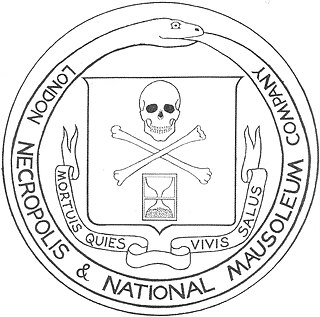
The London Necropolis Railway was a railway line opened in November 1854 by the London Necropolis Company (LNC), to carry corpses and mourners between London and the LNC's newly opened Brookwood Cemetery, 23 miles (37 km) southwest of London in Brookwood, Surrey. At the time the largest cemetery in the world, Brookwood Cemetery was designed to be large enough to accommodate all the deaths in London for centuries to come, and the LNC hoped to gain a monopoly on London's burial industry. The cemetery had intentionally been built far enough from London so as never to be affected by urban growth and was dependent on the recently invented railway to connect it to the city.